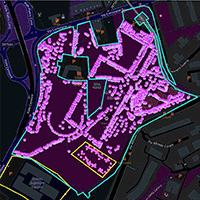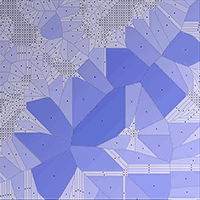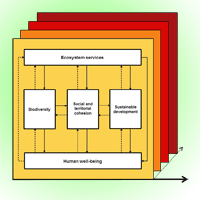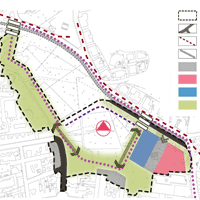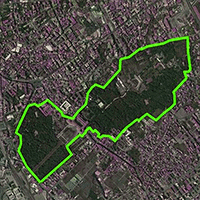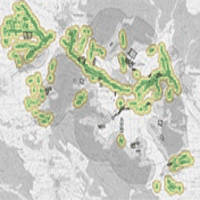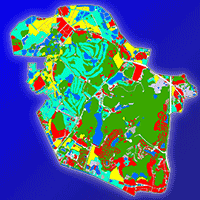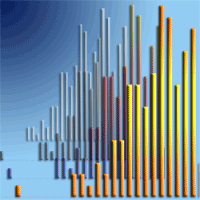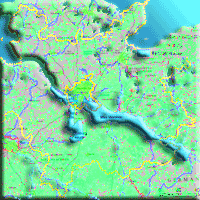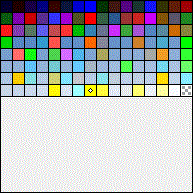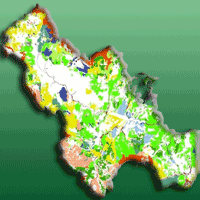Trees have a great value in terms of ecosystem services in urban areas. LIFE CLIVUT is an “Information and Governance” European project developed in 4 Mediterranean Cities, with the goal of increasing the knowledge and awareness of citizens, especially young people, on the importance of the presence and good management of urban trees to mitigate the “Heat Island” effects. The data collected on the value of tree heritage and their future potential are used to design a green asset management strategy that will help urban planners adopt better practices for the mitigation of the effects of climate change in urban environments. This paper illustrates the results of tree census activity in four urban green areas of Perugia, Central Italy, that will be compared with those recorded in others cities involved in the project. Dendrometric parameters (diameter at breast height, tree height, first branch height, max and min crown width, crown shape and density) were recorded in situ using a dedicated software operating through a web app (“Clivut-Treedb”). The following ecosystem services were estimated: CO2 sequestration, particulate matter (PM) absorption, shadow effect, biodiversity indexes. Several tree species characterized by important wood structures during their adult phase, such as Pinus pinea, Quercus ilex, Q. pubescens, Ulmus carpinifolia, Populus alba and Aesculus hippocastanum showed the highest estimates of CO2 stored. Q. ilex was the most efficient species in particulate adsorption, showing similar estimates (about 60 g PM10 tree-1 year-1) in the 3 oldest green areas established in the 1980s, while the youngest plantations (dating back to 2005) absorbed about 10 g tree-1 of PM10 per year. In terms of the potential cooling effect of trees, preliminary estimates of the shaded areas highlighted the difference between the older green areas (about 50% of shading) compared to the younger ones (about 15% and 8%).
Keywords
, , ,
Citation
Orlandi F, Fornaciari M, Ranfa A, Proietti C, Ruga L, Meloni G, Burnelli M, Ventura F (2022). LIFE-CLIVUT, ecosystem benefits of urban green areas: a pilot case study in Perugia (Italy). iForest 15: 133-140. - doi: 10.3832/ifor3908-015
Academic Editor
Raffaele Lafortezza
Paper history
Received: Jun 21, 2021
Accepted: Feb 05, 2022
First online: Apr 09, 2022
Publication Date: Apr 30, 2022
Publication Time: 2.10 months
© SISEF - The Italian Society of Silviculture and Forest Ecology 2022
Open Access
This article is distributed under the terms of the Creative Commons Attribution-Non Commercial 4.0 International (https://creativecommons.org/licenses/by-nc/4.0/), which permits unrestricted use, distribution, and reproduction in any medium, provided you give appropriate credit to the original author(s) and the source, provide a link to the Creative Commons license, and indicate if changes were made.

Breakdown by View Type
(Waiting for server response...)
Article Usage
Total Article Views: 9312
(from publication date up to now)
Breakdown by View Type
HTML Page Views: 4130
Abstract Page Views: 2861
PDF Downloads: 1792
Citation/Reference Downloads: 5
XML Downloads: 524
Web Metrics
Days since publication: 1346
Overall contacts: 9312
Avg. contacts per week: 48.43
Article Citations
Article citations are based on data periodically collected from the Clarivate Web of Science web site
(last update: Mar 2025)
Total number of cites (since 2022): 6
Average cites per year: 1.50
Publication Metrics
by Dimensions ©
Articles citing this article
List of the papers citing this article based on CrossRef Cited-by.
(1)
Beckett KP, Freer-Smith PH, Taylor G (2000)Particulate pollution capture by urban trees: effect of species and windspeed. Global Change Biology 6: 995-1003.
CrossRef |
Gscholar
(2)
Bottalico F, Chirici G, Giannetti F, De Marco A, Nocentini S, Paoletti E, Salbitano F, Sanesi G, Serenelli C, Travaglini D (2016)Air pollution removal by green infrastructures and urban forests in the city of Florence. Agriculture and Agricultural Science Procedia 8: 243-251.
CrossRef |
Gscholar
(3)
Carrus G, Scopelliti M, Lafortezza R, Colangelo G, Ferrini F, Salbitan F, Agrimi M, Portoghesi L, Semenzato P, Sanesi G (2015)Go greener, feel better? The positive effects of biodiversity on the well-being of individuals visiting urban and peri-urban green areas. Landscape and Urban Planning 134: 221-228.
CrossRef |
Gscholar
(4)
Carter JG (2011)Climate change adaptation in European cities. Current Opinion in Environmental Sustainability 3: 193-198.
CrossRef |
Gscholar
(5)
Carter JG, Cavan G, Connelly A, Guy S, Handley J, Kazmierczak A (2015)Climate change and the city: building capacity for urban adaptation. Program Planning 95: 1-66.
CrossRef |
Gscholar
(6)
Cuny HE, Rathgeber CB, Frank D, Fonti P, Mäkinen H, Prislan P, Rossi S, del Castillo EM, Campelo F, Vavrčík H, Camarero JJ, Bryukhanova MV, Jyske T, Gričar J, Gryc V, De Luis M, Vieira J, ÄŒufar K, Kirdyanov AV, Oberhuber W, Treml V, Huang JG, Li X, Swidrak I, Deslauriers A, Liang E, Nöjd P, Gruber A, Nabais C, Morin H, Krause C, King G, Fournier M (2015)Woody biomass production lags stem-girth increase by over one month in coniferous forests. Nature Plants 1 (11): 86.
CrossRef |
Gscholar
(7)
Freer-Smith PH, El-Khatib AA, Taylor G (2004)Capture of particulate pollution by trees: a comparison of species typical of semi-arid areas (
Ficus nitida and
Eucalyptus globulus) with European and North American species. Water Air and Soil Pollution 155: 173-187.
CrossRef |
Gscholar
(8)
Gill SE, Handley JF, Ennos AR, Pauleit S (2007)Adapting cities for climate change: the role of the green infrastructure. Built Environment 33 (1): 115-133.
CrossRef |
Gscholar
(9)
GlobalAllomeTree (2020)Assessing volume, biomass and carbon stocks of trees and forests. Web site.
Online |
Gscholar
(10)
Kabisch N, Korn H, Stadler J, Bonn A (2017)Nature-based solutions to climate change adaptation in urban areas. In: “Linkages between Science, Policy and Practice. Theory and Practice of Urban Sustainability Transitions” (Kabisch N, Korn H, Stadler J, Bonn A eds). Springer International Publishing AG, pp. 342.
CrossRef |
Gscholar
(11)
Lamlom SH, Savidge RA (2003)A reassessment of carbon content in wood: variation within and between 41 North American species. Biomass and Bioenergy 25: 381-388.
CrossRef |
Gscholar
(12)
Leuzinger S, Vogt R, Körner C (2010)Tree surface temperature in an urban environment. Agricultural and Forest Meteorology 150: 56-62.
CrossRef |
Gscholar
(13)
Manes F, Silli V, Salvatori E, Incerti G, Galante G, Fusaro L, Perrino C (2014)Urban ecosystem services: tree diversity and stability of PM10 removal in the metropolitan area of Rome. Annali di Botanica 4: 19-26.
Gscholar
(14)
Massetti L, Petralli M, Brandani G, Napoli M, Ferrini F, Fini A, Pearlmutter D, Orlandini S, Giuntoli A (2019)Modelling the effect of urban design on thermal comfort and air quality: the SMARTUrban Project. Building Simulation 12: 169-175.
CrossRef |
Gscholar
(15)
McPherson G, Nowak D, Rowntree A (1994)Chicago’s urban forest ecosystem: results of the Chicago urban forest climate project. Gen. Tech. Rep. NE-186, USDA Forest Service, Northeastern Forest Experiment Station, Radnor, PA, USA, pp. 201.
Online |
Gscholar
(16)
McPherson E, Van Doorn G, Natalie S, Peper PJ (2016)Urban tree database and allometric equations. Gen. Tech. Rep. PSW-GTR-253, USDA Forest Service, Pacific Southwest Research Station, Albany, CA, USA, pp. 86.
CrossRef |
Gscholar
(17)
Ning ZH, Chambers R, Abdollahi K (2016)Modeling air pollutant removal, carbon storage, and CO
2 sequestration potential of urban forests in Scotlandville, Louisiana, USA. iForest 9: 860-867.
CrossRef |
Gscholar
(18)
Nowak DJ (2020)Understanding i-Tree: summary of programs and methods. Gen. Tech. Rep. NRS-200, USDA Forest Service, Northern Research Station, Madison, WI, USA, pp. 100.
CrossRef |
Gscholar
(19)
Nowak DJ (1994)Atmospheric carbon dioxide reduction by Chicago’s urban forest. In: “Chicago’s Urban Forest Ecosystem Results Chicago Urban Forest Climate Project” (McPherson EG, Nowak DJ, Rowntree R eds). Gen. Tech. Rep. NE-186, USDA Forest Service, Northeastern Forest Experiment Station, Radnor, PA, USA, pp. 83-94.
Online |
Gscholar
(20)
Nowak DJ, Crane DE (2000)The urban forest effects (UFORE) model: quantifying urban forest structure and functions. In: “Integrated Tools For Natural Resources Inventories in the 21st Century” (Hansen M, Burk T eds). Gen. Tech. Rep. NC-212, USDA Forest Service, North Central Forest Experiment Station, St. Paul, MN, USA, pp. 714-720.
Online |
Gscholar
(21)
Nowak DJ, Crane DE, Stevens JC (2006)Air pollution removal by urban trees and shrubs in the US. Urban Forestry and Urban Greening 4: 115-123.
CrossRef |
Gscholar
(22)
Nowak DJ, Dwyer JF (2010)Understanding the benefits and costs of urban forest ecosystems. In: “Urban and Community Forestry in the Northeast (2nd edn)” (Kuser JE). Springer, Dordrecht, Netherlands, pp. 25-46.
CrossRef |
Gscholar
(23)
Nowak DJ, Hirabayashi S, Bodine A, Hoehn R (2013)Modeled PM2.5 removal by trees in ten U.S. cities and associated health effects. Environmental Pollution 178: 395-402.
CrossRef |
Gscholar
(24)
Paoletti E, Bardelli T, Giovannini G, Pecchioli L (2011)Air quality impact of an urban park over time. Procedia Environmental Sciences 4 (140): 10-16.
CrossRef |
Gscholar
(25)
Potchter O, Cohen P, Bitan A (2006)Climatic behavior of various urban parks during hot and humid summer in the Mediterranean city of Tel Aviv, Israel. International Journal of Climatology 26: 1695-1711.
CrossRef |
Gscholar
(26)
QGIS.org (2021)QGIS geographic information system. The QGIS Association, web site.
Online |
Gscholar
(27)
Russo A, Escobedo FJ, Timilsina N, Schmitt AO, Varelad S, Zerbea S (2014)Assessing urban tree carbon storage and sequestration in Bolzano, Italy. International Journal of Biodiversity Science, Ecosystem Services and Management 10 (1): 54-70.
CrossRef |
Gscholar
(28)
Sæbø A, Borzan Z, Ducatillion C, Hatzistathis A, Lagerstrom T, Supuka J, Van Slycken J (2005)The selection of plant materials for street trees, park trees and urban woodland. In: “Urban Forests and Trees”. Springer, Berlin, Heidelberg, Germany, pp. 257-280.
Online |
Gscholar
(29)
Sæbø A, Popek R, Nawrot B, Hanslin HM, Gawronska H, Gawronski SW (2012)Plant species differences in particulate matter accumulation on leaf surfaces. Science of the Total Environment 427: 347-354.
CrossRef |
Gscholar
(30)
Shannon CE, Weaver W (1949)The mathematical theory of communication. University of Illinois Press, Urbana, IL, USA, pp. 125.
Gscholar
(31)
Shashua-Bar L, Hoffman ME (2000)Vegetation as a climatic component in the design of an urban street. An empirical model for predicting the cooling effect of urban green areas with trees. Energy and Buildings 31: 221-235.
CrossRef |
Gscholar
(32)
Shashua-Bar L, Potchter O, Bitan A, Boltansky D, Yaakov Y (2010)Microclimate modelling of street tree species effects within the varied urban morphology in the Mediterranean city of Tel Aviv, Israel. International Journal of Climatology 30: 44-57.
CrossRef |
Gscholar
(33)
Sinacore K, Hall JS, Potvin C, Royo AA, Ducey MJ, Ashton MS (2017)Unearthing the hidden world of roots: root biomass and architecture differ among species within the same guild. PLoS One 12 (10): e0185934.
CrossRef |
Gscholar
(34)
Tritton LM, Hornbeck JW (1982)Biomass equations for major tree species of the Northeast. Gen. Tech. Rep. no. 69, USDA Forest Service, Broomall, PA, USA, pp. 46.
Online |
Gscholar
(35)
Vlachokostas C, Michailidou AV, Matziris E, Achillas C, Moussiopoulos N (2014)A multiple criteria decision-making approach to put forward tree species in urban environment. Urban Climate 10 (1): 105-118.
CrossRef |
Gscholar
(36)
Yu C, Hien WN (2006)Thermal benefits of city parks. Energy and Buildings 38: 105-20.
CrossRef |
Gscholar
(37)
Yue XL, Gao QX (2018)Contributions of natural systems and human activity to greenhouse gas emissions. Advances in Climate Change Research 9 (4): 243-252.
CrossRef |
Gscholar
(38)
Zianis D, Muukkonen P, Mäkipää R, Mencuccini M (2005)Biomass and stem volume equations for tree species in Europe. Silva Fennica Monographs 2005 (4): 1-63.
CrossRef |
Gscholar
